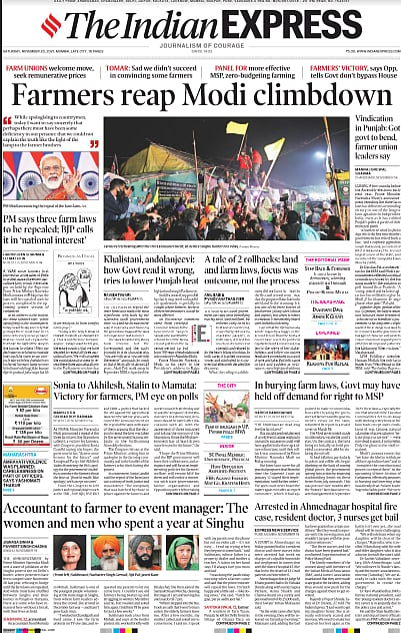Broken News
Published in Newslaundry on February 28, 2025
Link: https://www.newslaundry.com/2025/02/28/us-tariffs-impact-on-economy-usaid-row-helps-bury-the-big-questions
Can the media avoid falling for the politics of distraction? Apparently not, as far as the media in India is concerned.
There is no better illustration of this than the recent controversy over an apparent US $21 million that USAID is supposed to have given to an organisation based in Washington DC to fund “voter turnout” in India. This came up because US President Donald Trump has gone on something of a warpath against USAID, claiming it was wasting his country’s funds by giving money to countries for projects that were unsupportable.
If this was the case, then there was no story there. But the decision to cancel USAID for projects overseas took a turn in India that could have been considered funny if it wasn’t so pathetic.
Within days of Trump’s announcement about cancelling the $21 million for India, the blame game was in full swing. The BJP’s Information and Technology Cell head Amit Malviya called the Congress party “desperate” and accused it of routing the USAID fund through “various George Soros-linked fronts and a labyrinth of NGO structures to meddle with India’s electoral process”. Congress spokesperson Jairam Ramesh responded by pointing out that “USAID is currently implementing seven projects in collaboration with the government of India, with a combined budget of approximately $750 million. Not a single of these projects has to do with voter turnout. All of them are with and through the Union government.”
To add masala to this “unhinged public discourse”, as The Hindu termed it in its editorial, the originator of the controversy, Donald Trump himself, added to the confusion by first reiterating that the funds had been given because “I guess they were trying to get somebody else elected.” And then claiming the funds were going “to my friend Prime Minister Modi in India for voter turnout”, and then arbitrarily reducing the amount from $21 million to $18 million.
Meanwhile, the Indian media, especially television news that loves a good controversy, parroted all this without as much as a raised eyebrow.
Fortunately, we still have some print media organisations that do what any journalistic endeavour should do: investigate and find out facts.
The Indian Express led with a front-page story that established that the magical figure of $21 million was the exact same as what USAID had given to organisations in Bangladesh in the run-up to the 2024 general elections. And the USAID website had no record of a similar amount going to India. So, did Trump get mixed up between Dhaka and Delhi? Or was this part of a deliberate strategy to stir up a controversy?
The controversy ought to have been settled after the Indian Express story. Subsequently more “facts”, rather than rhetoric, appeared in the print media when official government documents established that in the last four years, the government has received $650 million for a variety of projects as outlined by the fact-check site Boom. And that over the years, irrespective of the government in power, USAID has been funding official government projects in India – including healthcare, education and sanitation – as illustrated by this graphic in Times of India.

In addition to this, it is entirely possible that some non-governmental organisations received funds from foundations or non-profits in the US that were partly funded by USAID. Even if some did, we still need to establish if any of them were even remotely involved in something as political as enhancing “voter turnout”. Given that the Modi government has cancelled the FCRA (Foreign Contributions Regulation Act) licenses of thousands of NGOs, it is unlikely that any of those considered even remotely political would have survived the axe.
Apart from finding out the facts and reporting them, rather than routinely repeating accusations by politicians on both sides, what really needs to be investigated is why the BJP trumped this up as a major controversy for which predictably, both the opposition and mainstream media fell. And who gains from it.
This politics of distraction is now a well-known ploy. As Ravish Kumar points out in one of his recent programmes, while we were discussing many non-issues, the country’s stock markets were falling and no one was asking the government why this was happening. While the governments of Assam and Madhya Pradesh were hosting “global” investment meetings, there was hardly any discussion about the consequences of Trump’s threat that he would charge India the same tariffs as India charged for US imports. How would this affect the Indian economy and foreign investment? Did the Modi government have a strategy to handle the consequences of raised tariffs? These questions were left hanging in the air.
And as suddenly as it popped up, the USAID controversy has disappeared. The government has not confirmed or denied this mythical sum of $21 million for “voter turnout” despite making statements that it was concerned and was looking into it. And the Indian media has dropped the subject.
Also, now that the Maha Kumbh has ended, even the controversy about the quality of the water in the Ganges in which millions of people took a dip, generated by the report of the Central Pollution Control Board, will not be discussed anymore even though the state of India’s rivers ought to be an urgent concern for everyone, irrespective of their religious significance.
To end, I leave you with this article by Shailendra Yashwant in Deccan Herald on the state of the Yamuna, one of the three rivers that form part of the Sangam in Prayagraj. It reminds us of the crisis our rivers face as they continue to be blocked by dams and barrages, slowing down their natural flow, and then treated as sewers along the way by every town and city on their banks until their waters are not only unfit for drinking but even for bathing.
